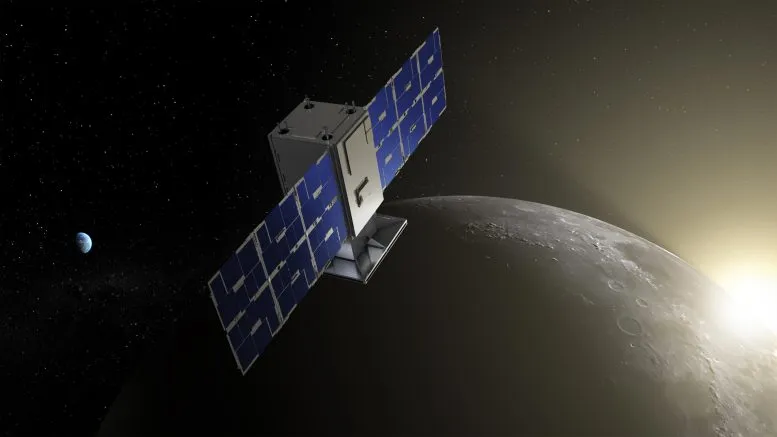CAPSTONE will reach the Moon's surface today, November 13, and will be the first spacecraft to reach a novel, an extended orbit that will assist NASA's Artemis missions. The primary goal of CAPSTONE is to test and validate the estimated orbital stability of a Near Rectilinear Halo Orbit over the Moon, which is also the orbit intended for Gateway according to CAPSTONE Rocket Lab USA. NASA's Gateway is a tiny space station that will circle the Moon and provide access to the planet's surface to astronauts.
It will have astronaut living quarters, a scientific and research lab, and connections for visiting spaceships. CAPSTONE will also put to the test an Advanced Space navigation system that will determine its absolute position in cislunar space by interacting therewith NASA's Lunar Reconnaissance Orbiter without the need for ground stations for navigational support.
CAPSTONE has been charting an unconventional but effective deep-space path to the Moon for the past four months. This path, known as a ballistic lunar transfer, follows gravity patterns in deep space thus allowing spacecraft to arrive at their target with little energy expenditure. Advanced Space, a Colorado local company that owns and manages CAPSTONE on account of NASA, created this one-of-a-kind trajectory.
Micro-Sized Spacecraft with Important Space Role
Cislunar Autonomous Positioning System Technology Operations and Navigation Experiment (CAPSTONE) is a micro oven-sized satellite weighing about 55 pounds that will be the first CubeSat to fly to and operate on the Moon. It serves as a test bed for Gateway, a Moon-orbiting moon base part of NASA's Artemis program. The mission of CAPSTONE will assist decrease risk for the development spacecraft, particularly Orion, by validating revolutionary navigation systems and confirming the dynamics of a sort of mass effect orbit that has never been launched before.
The gravitational forces from the Moon and Earth combine in this peculiar orbit, technically defined as the Near Rectilinear Halo Orbit (NHRO), to enable such a semi-stable orbit. Physics conducts the majority of the work in maintaining spacecraft in orbit around the Moon.
In comparison to other comparable orbits, this minimizes the requirement for spacecraft to consume fuel to sustain the NRHO. NASA mentioned that it already has enormous ambitions for this sort of orbit. Engineers anticipate that it will empower them to keep larger spacecraft, like Gateway, in orbit around the Planet for at least 15 years. Fuel efficiency is critical for such long-duration trips.
Prior and Upcoming CAPSTONE Space Missions
Over the past four months, CAPSTONE has completed five maneuvers to align its course for orbital flight, with the crew responding to unanticipated hurdles to maintain CAPSTONE on schedule. The spacecraft arrived at the Moon on October 27 after the last maneuver. As SciTechDaily noted, when CAPSTONE approaches the conclusion of its gravity-driven path and lands at the Moon, it will be ideally positioned for NRHO insertion - the vital point of its voyage. Though the timetable of CAPSTONE's previous operations was variable due to the spacecraft's effectiveness and other considerations, this orbit insertion should occur at precisely the appropriate moment to place CAPSTONE in the appropriate orbit.
It will conduct its delicate, precisely orchestrated propulsive maneuver to reach orbit while going 3,800 miles per hour, similar to a flying trapeze performer who leaps from one arc to the next using a decisive, acrobatic action. The first orbital insertion maneuver is scheduled for Sunday, November 13, at 7:18 p.m. EST. The CAPSTONE team anticipates that analyzing data, performing two clean-up operations, and confirming effective integration into near rectilinear halo orbit will require at least five days.
Other objectives await this pathfinder CubeSat after that. After being in lunar orbit, CAPSTONE is expected to fire its engines once every six and a half days, if necessary, to stay in orbit for at least 6 months, enabling NASA as well as its partners to learn how to navigate the moon.

CAPSTONE revealed in lunar Sunrise: CAPSTONE will fly in cislunar space – the orbital space near and around the Moon. The mission will demonstrate an innovative spacecraft-to-spacecraft navigation solution at the Moon from a near rectilinear halo orbit slated for Artemis’ Gateway. First to enter the deep space route, the micro CAPSTONE spacecraft will launch to support NASA's Artemis Missions.
ALSO READ: NASA Engineers Finally Controls Moon-Bound CAPSTONE Space Probe
Additional Developed Software of CAPSTONE
CAPSTONE, in particular, will test the propulsion needs for sustaining its orbit as anticipated by models, lowering logistical uncertainty for future missions. In addition, the Cislunar Autonomous Positioning System (CAPS), a critical software technology, will be evaluated in the coming months. CAPS will exhibit revolutionary spacecraft-to-spacecraft navigation technologies, allowing future spacecraft to establish their location without relying solely on tracking from Earth.
To identify its position in space, CAPSTONE will communicate with NASA's Lunar Reconnaissance Orbiter, which has been orbiting the Moon since 2009. This feature might allow future spacecraft to operate independently with minimal assistance from the ground, as well as enable surface antennas to prioritize vital research data above regular operational tracking, as added by NASA's press release.
The CAPSTONE mission will showcase several technologies that will establish the groundwork for commercial sponsorship of future lunar missions. NASA partners are putting cutting-edge flight planning and operations technologies to the test, opening the road and extending options for small and less expensive space adventure exploration missions on the Moon, Mars, as well as other destinations around the solar system.
RELATED ARTICLE: CAPSTONE Update: Owner, Operator Advanced Space Announces It's Currently Working to Address the Spacecraft's Tumbling Issue
Check out more news and information on CAPSTONE in Science Times.



![Humans Will Go Extinct on Earth in 250 Million Years; Mass Extinction Will Occur Sooner if Burning Fossil Fuels Continues [Study]](https://1721181113.rsc.cdn77.org/data/thumbs/full/53373/89/56/50/40/humans-will-go-extinct-on-earth-in-250-million-years-mass-extinction-will-occur-sooner-if-burning-fossil-fuels-continues-study.jpeg)










